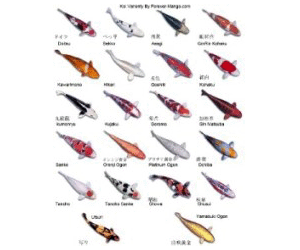Varieties of Koi
Regardless of their colour and patterns, all koi are classified as carp, Cyprinus carpio. Although a variety of different breeding programs have created a large range of morphological varieties. The largest breeders of koi are the Japanese; it is because of this that the many varieties of koi are all named and classified using Japanese terminology.
In Japan they categorize koi varieties according to many features that include their patterns, colour, scale type and arrangement. There is an economic and aesthetic hierarchy of color, form and pattern that determines how valuable and desirable the koi will be. There are many subtleties involved in the judging of these fish, some of the common koi are easy to distinguish as the features are easily spotted allowing the koi to be assigned to a specific group.
The range of words and phrases used to describe koi in Japanese can sometimes be standard descriptions, poetical an analogies that have political references, the actual words used are many a time un-translated so the meanings are lost and unknown to many westerners.
Some are loosely translated though and are usually abstract descriptions based on what the patterns on the koi resemble. Budo, for example, translates literally to grape. What does this have to do with a koi? Basically, the patterns on the fish would resemble a bunch of grapes, hence the name, pure and simple. Another example is Karasu, which translates to crow in English. Obviously then, the Karasu is an all black fish with little or no markings at all. They are thought to bring the best luck of all the koi fish. There is a fine line in the translations in both meaning and context. If you get the direct translation, just use common sense and the name should make sense.
In other cases, you may have to do some research to understand what the Japanese meant when they classified this fish. In a lot of cases, all you need to do is understand the translations of words for colors, such as: ai, meaning blue, sumi, meaning black and kin, meaning gold. A lot of the names for these fish in Japanese are combinations of colors and other distinguishing features.
 Back to the Home Page
Back to the Home Page© 2025 Koi Care

